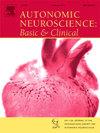运动中心血管控制异常:胰岛素抵抗在大脑中的作用。
IF 3.2
4区 医学
Q2 NEUROSCIENCES
引用次数: 0
摘要
在运动过程中,为满足氧气需求而进行的循环调节是由多种自主神经机制介导的,包括骨骼肌运动加压反射(EPR)、压力反射(BR)以及来自高级脑中枢的中央指令神经元的前馈信号。外周组织的胰岛素抵抗包括高胰岛素血症对骨骼肌传入神经的敏化,这是糖尿病动物模型和患者中观察到的EPR功能异常升高的部分原因。然而,胰岛素信号在中枢神经系统(CNS)中的作用作为潜在的胰岛素抵抗疾病的治疗干预受到越来越多的关注。这篇综述将强调我们对胰岛素抵抗如何诱导中枢信号变化的理解的最新进展。中枢胰岛素信号的改变导致心血管对运动的异常反应。特别地,我们将讨论胰岛素信号在髓系心血管控制核中的作用。孤立束核(NTS)和延髓吻侧腹外侧核(RVLM)是胰岛素调节心血管反射的关键核。EPR、BR和中枢指令的第一个整合位点是NTS,它在表达胰岛素受体(IRs)的神经元中含量很高。这些神经元上的ir可以很好地调节心血管对运动的反应。此外,IR密度的差异和受体同种异构体的存在使得胰岛素在中枢神经系统内的作用具有特异性和多样性。因此,无创向中枢神经系统输送胰岛素可能是胰岛素抵抗患者运动后心血管反应正常化的有效手段。本文章由计算机程序翻译,如有差异,请以英文原文为准。
Abnormal cardiovascular control during exercise: Role of insulin resistance in the brain
During exercise circulatory adjustments to meet oxygen demands are mediated by multiple autonomic mechanisms, the skeletal muscle exercise pressor reflex (EPR), the baroreflex (BR), and by feedforward signals from central command neurons in higher brain centers. Insulin resistance in peripheral tissues includes sensitization of skeletal muscle afferents by hyperinsulinemia which is in part responsible for the abnormally heightened EPR function observed in diabetic animal models and patients. However, the role of insulin signaling within the central nervous system (CNS) is receiving increased attention as a potential therapeutic intervention in diseases with underlying insulin resistance. This review will highlight recent advances in our understanding of how insulin resistance induces changes in central signaling. The alterations in central insulin signaling produce aberrant cardiovascular responses to exercise. In particular, we will discuss the role of insulin signaling within the medullary cardiovascular control nuclei. The nucleus tractus solitarius (NTS) and rostral ventrolateral medulla (RVLM) are key nuclei where insulin has been demonstrated to modulate cardiovascular reflexes. The first locus of integration for the EPR, BR and central command is the NTS which is high in neurons expressing insulin receptors (IRs). The IRs on these neurons are well positioned to modulate cardiovascular responses to exercise. Additionally, the differences in IR density and presence of receptor isoforms enable specificity and diversity of insulin actions within the CNS. Therefore, non-invasive delivery of insulin into the CNS may be an effective means of normalizing cardiovascular responses to exercise in patients with insulin resistance.
求助全文
通过发布文献求助,成功后即可免费获取论文全文。
去求助
来源期刊
CiteScore
5.80
自引率
7.40%
发文量
83
审稿时长
66 days
期刊介绍:
This is an international journal with broad coverage of all aspects of the autonomic nervous system in man and animals. The main areas of interest include the innervation of blood vessels and viscera, autonomic ganglia, efferent and afferent autonomic pathways, and autonomic nuclei and pathways in the central nervous system.
The Editors will consider papers that deal with any aspect of the autonomic nervous system, including structure, physiology, pharmacology, biochemistry, development, evolution, ageing, behavioural aspects, integrative role and influence on emotional and physical states of the body. Interdisciplinary studies will be encouraged. Studies dealing with human pathology will be also welcome.

 求助内容:
求助内容: 应助结果提醒方式:
应助结果提醒方式:


